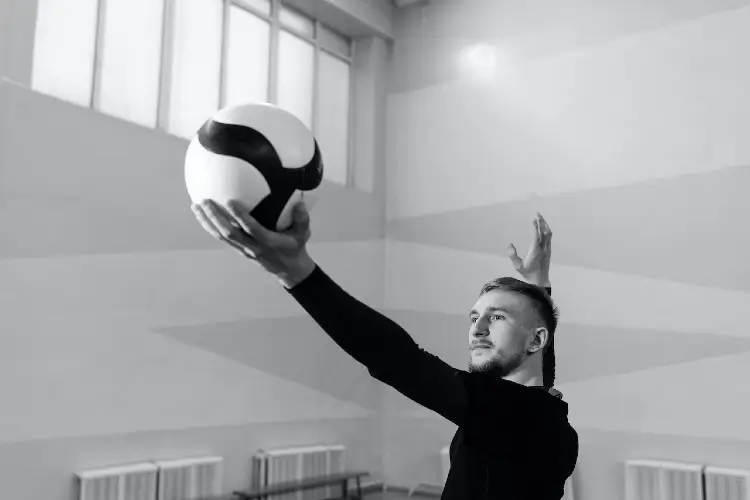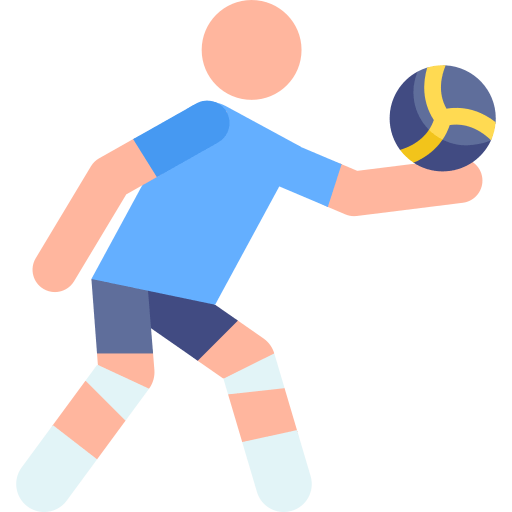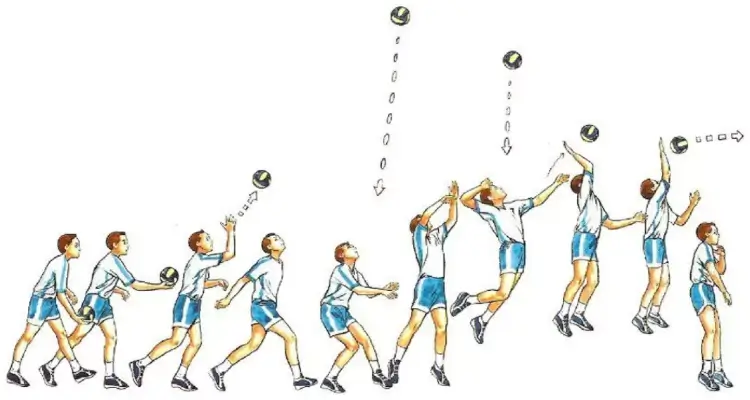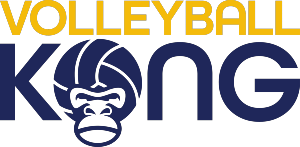Last Updated: January 9, 2024
When playing volleyball, one of the important techniques to know is serving. This is basically an offensive skill that starts a match, every set and every point.
The server sets the pace of the rally. When a serve is executed properly, the rally can wrap up with a score for the serving team.
The serve is the only move where the player has full control of the ball. It is important to master it to the best of your ability so you can take full advantage of it. Fortunately, this is one of the parts of the game that are easiest to learn and master.
Common Serve Techniques to Use

1. Underhand Serve
The underhand serve is the first technique for volleyball beginners to learn. It is the easiest one to master, execute, and control as it has few requirements.
You use the steps below to start a rally with an underhand serve (for right-handed):
 Have the feet in an up-and-back stride position. The right foot is back and bears the body weight
Have the feet in an up-and-back stride position. The right foot is back and bears the body weight Hold the ball in front of your right hip, slightly below the waist
Hold the ball in front of your right hip, slightly below the waist Lean the upper body and the shoulders slightly forward
Lean the upper body and the shoulders slightly forward Focus your eyes on the lower section of the ball, which is the contact point
Focus your eyes on the lower section of the ball, which is the contact point Toss the ball in the air with the non-dominant hand
Toss the ball in the air with the non-dominant hand Swing the dominant hand as a pendulum backward and then forward to strike the ball
Swing the dominant hand as a pendulum backward and then forward to strike the ball Contact and strike the ball with an open and flat palm
Contact and strike the ball with an open and flat palm Hit the ball below the mid-section or the equator
Hit the ball below the mid-section or the equator Drop your left hand as you contact the ball. Also, shift the weight from the back foot to the front foot
Drop your left hand as you contact the ball. Also, shift the weight from the back foot to the front foot
2. Overhand Serve
The overhand serve (or overhead serve) is a move that every volleyball player should learn. However, it is tougher to master than an underhand serve. The ball comes and drops faster in a “toss, draw, step, and swing” cue.
An overhead serve is popular in high school, college, and international volleyball games. A player makes contact with the ball over the head. The move appears as throwing the ball.
Common overhead serve techniques include:
Topspin serve
The server hits the ball to send it in a particular direction. The move causes the ball to spin, dive, and hit the court surface. When a player makes a hard topspin serve, it is important to keep the ball in bounds.
Float serve
The server hits the ball in the air with an unpredictable float move. A float serve does not spin the ball. The strike sends the ball over the net in a random direction that is difficult for the opponents to predict to position a pass.
When doing a float serve, the player keeps the wrist firm to strike or slap the ball without a follow-through. For the best float serve, the fingers should not contact the ball.
Jump serve
A jump serve is for skilled players and it takes time to master and perfect the move. The serve is a back-row attack where the player stands several steps behind the serve line.
To do a jump serve, a player tosses the ball in the air, takes three steps forward, jumps, and strikes the ball while still behind the boundary.

For a perfect jump serve, a player has to snap the wrist for maximum spin. The move dives and lands the ball in bounds. If done incorrectly, the ball may sail out of the play court.
How to Execute a Good Overhand Serve
With these helpful guidelines you can learn and execute a good overhand serve.
Hands positions and motions
Hands positions and motions are summed up as bow and arrow. It’s a technique that seems like an “aim and shoot” of a bow and an arrow.
The left hand (or less dominant hand) holds the ball, while the dominant hand strikes the ball.
Like when using a bow and arrow, the players’ hands are high alongside the ears. The hand with the ball is in front, while the other is behind, ready to hit the ball.
Feet position
During an overhead serve, a player should have the feet shoulder-width apart. The left foot should be slightly ahead of the right foot. The weight of the player transfers from the left foot to the right as the player serves the ball.
Serve position
To master an overhand serve, a player should practice serving from a 10-foot line to avoid a serve fault. Repeat the move until you successfully learn to serve from behind the line.
Making contact
Use the steps below to make contact with the ball:
 Take a few steps behind the serve line to start the serve
Take a few steps behind the serve line to start the serve Toss the ball in the air as you take steps forward
Toss the ball in the air as you take steps forward Get into the serve zone and hit the ball
Get into the serve zone and hit the ball
Toss
Toss is the ball position you use to contact the ball. If you are right-handed, toss the ball in the air with your left hand. Meanwhile, have your dominant right hand behind your back, ready to contact the ball. Practice until you can make a perfect toss with your left hand.
While doing a toss, servers should throw the ball as high as is comfortable for them. There isn’t a standard height a toss should go.
Recommended read: Serving Strategies Unleashed: Top Techniques for a Winning Serve
3. Sky Ball Serve
Skyball serve is a beach volleyball serve technique. The rare serve uses an underhand serve position to send the ball 20 to 30 feet high. The skill requires the ball to fly with a lot of topspin once served.
A calculating serve takes advantage of the bright sky and windy conditions to make an easy score. The light sky, wind, and the 20 to 30-foot height make it difficult for the receivers to track the ball. The ball also comes down at an unpredictable angle the receiving team cannot position to pass.
Most volleyball teams do not use the skyball serve as it is difficult to learn and master.
Below are the steps to execute a sky ball serve:
- Get into an underhand serve position where the ball is in front of the body with the eyes focused on the contact point
- Do a little pre-spin with the non-dominant hand
- Stretch the dominant hand backward, ready to strike the ball hard
- Hit the ball very fast from below the equator
- Send the ball in a straight line toward the desired direction
- Make more contacts with the back of the ball to create continuous topspin as it flies forward and on an upward trajectory
Basic Serve Rules
Volleyball is a regulated sport with rules and regulations that teams observe. Players are expected to know and adhere to serve rules to score points and avoid penalties.
Below are some of the basic serve rules that govern the role:
- The referee tosses a coin to determine the team that will make the first serve to start the first set of a match
- The team that does not serve the first serve of the match does all the first serves of all the other sets of the match
- A new serve is done when a rally ends after a team commits a fault
- A server is positioned at the right-back position
- A serve is executed from behind the end line in the serve zone area. The serving area is 10 feet wide
- A serve should put the ball into play within eight seconds of getting into the serve position in the serve zone
- A player can use an overhand, underhand, topspin, float, jump, or any other serve to start a rally
- The ball must be visible to the receiving team when serving
- When the serving team wins a rally, the server that served the rally serves again
- When the receiver wins a rally, the team serves the new rally
- If the receiving team misses a serve, the serving team scores a point
Also read: 15-Point Checklist to Perfecting Your Volleyball Serve
Common Serve Faults
A serve fault happens when a serve is improperly executed. There are many ways that a player may commit a foul serve.
Below are some serve faults a player may commit when setting the ball to play:
 Failure to get the ball across the net to the opponent’s court
Failure to get the ball across the net to the opponent’s court Sending the ball out of the court boundaries or into the audience
Sending the ball out of the court boundaries or into the audience A foot fault of stepping on the service line
A foot fault of stepping on the service line An out-of-order serve. If the team does not rotate as required, the players, including the server may be in the wrong spots. A serve by a player that should not serve may be considered a fault depending on the referee’s judgment
An out-of-order serve. If the team does not rotate as required, the players, including the server may be in the wrong spots. A serve by a player that should not serve may be considered a fault depending on the referee’s judgment
Conclusion
Serve is an offensive volleyball technique and the first move that starts a match and new rallies. It is one of the important volleyball techniques that a person interested in the sport should master.
The serving player controls the ball to set the tandem of a rally. Every team aims to serve well to win a rally and score points. A skilled player pulls off a proper serve to win the team serve points.
